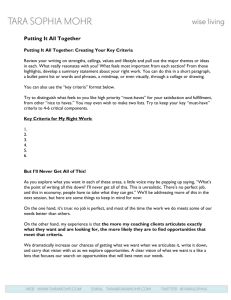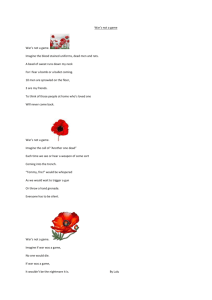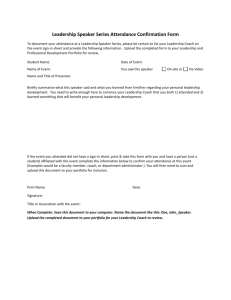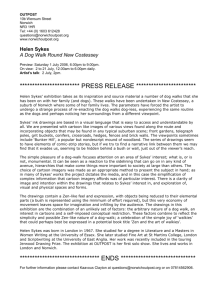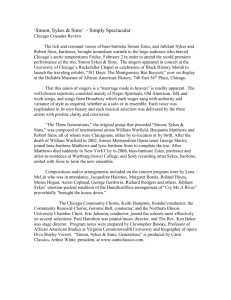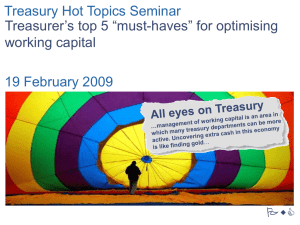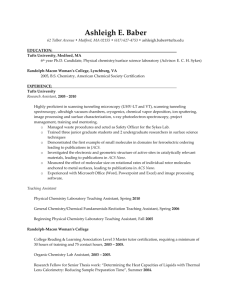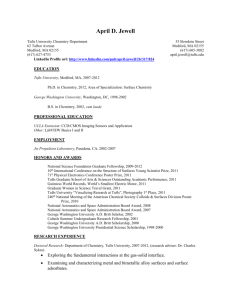Speaking Up For Yourself (or how to enjoy giving presentations)
advertisement
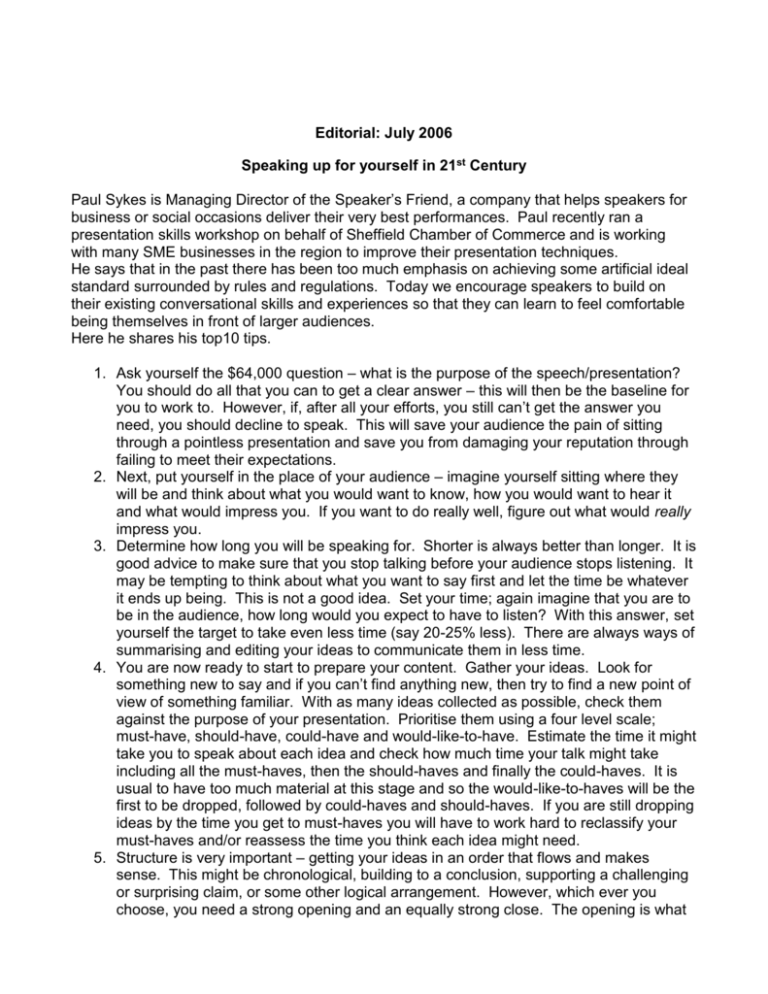
Editorial: July 2006 Speaking up for yourself in 21st Century Paul Sykes is Managing Director of the Speaker’s Friend, a company that helps speakers for business or social occasions deliver their very best performances. Paul recently ran a presentation skills workshop on behalf of Sheffield Chamber of Commerce and is working with many SME businesses in the region to improve their presentation techniques. He says that in the past there has been too much emphasis on achieving some artificial ideal standard surrounded by rules and regulations. Today we encourage speakers to build on their existing conversational skills and experiences so that they can learn to feel comfortable being themselves in front of larger audiences. Here he shares his top10 tips. 1. Ask yourself the $64,000 question – what is the purpose of the speech/presentation? You should do all that you can to get a clear answer – this will then be the baseline for you to work to. However, if, after all your efforts, you still can’t get the answer you need, you should decline to speak. This will save your audience the pain of sitting through a pointless presentation and save you from damaging your reputation through failing to meet their expectations. 2. Next, put yourself in the place of your audience – imagine yourself sitting where they will be and think about what you would want to know, how you would want to hear it and what would impress you. If you want to do really well, figure out what would really impress you. 3. Determine how long you will be speaking for. Shorter is always better than longer. It is good advice to make sure that you stop talking before your audience stops listening. It may be tempting to think about what you want to say first and let the time be whatever it ends up being. This is not a good idea. Set your time; again imagine that you are to be in the audience, how long would you expect to have to listen? With this answer, set yourself the target to take even less time (say 20-25% less). There are always ways of summarising and editing your ideas to communicate them in less time. 4. You are now ready to start to prepare your content. Gather your ideas. Look for something new to say and if you can’t find anything new, then try to find a new point of view of something familiar. With as many ideas collected as possible, check them against the purpose of your presentation. Prioritise them using a four level scale; must-have, should-have, could-have and would-like-to-have. Estimate the time it might take you to speak about each idea and check how much time your talk might take including all the must-haves, then the should-haves and finally the could-haves. It is usual to have too much material at this stage and so the would-like-to-haves will be the first to be dropped, followed by could-haves and should-haves. If you are still dropping ideas by the time you get to must-haves you will have to work hard to reclassify your must-haves and/or reassess the time you think each idea might need. 5. Structure is very important – getting your ideas in an order that flows and makes sense. This might be chronological, building to a conclusion, supporting a challenging or surprising claim, or some other logical arrangement. However, which ever you choose, you need a strong opening and an equally strong close. The opening is what gets people’s attention and sets them up to listen to you and the close is what you will leave in their minds. 6. Very few people are comfortable speaking without notes. Indeed, there is a strong argument for having notes whether you need them or not as it shows the audience that you are not just making it up and also that you are not missing out anything that is important. It doesn’t matter that this is illogical - it works! Therefore, on smallish sheets of paper or index cards write bullet point notes that are easy to read and that show key or trigger words reminding you of the point you need to make. Write out any direct quotes in full and feel free to read them; otherwise you should only use your notes as prompts. Make sure that you find a way of keeping your notes in the right order; dropping them and getting them in the wrong order can be very off-putting. 7. Practice your presentation – preferably in front of a video camera, a mirror, or someone who you trust to give you helpful feedback. If you can, get a professional presentation coach, not only will they be able to help you with rehearsal but also provide expert advice and inspiration at every other stage of the process. By the time it comes to the real event, your performance will be polished and you will be able to relax more and enjoy it. 8. Remain calm and composed. Take a couple of deep breaths before you start. Use pauses for effect throughout the presentation and also to compose yourself. Make a key point, and then pause for a few seconds for the message to sink it. You can use this as an opportunity to check your notes. This is also a sign of a more competent speaker and will make you feel more in control. 9. If you decide to use visual aids to enhance the presentation, make sure that is what they do. Never read word for word from projected slides, don’t use full sentences on your slides except in very special circumstances, and don’t feel that everything you say needs a visual aid. Introduce pictures and diagrams to emphasise key points – it will add interest and make your points more memorable, and don’t be afraid to ask your audience to imagine a visual aid – the theatre/cinema of the mind is very powerful. 10. Above all be enthusiastic, be passionate, it’s a people thing – if you don’t care about what you have to say then why should your audience? Put yourself into your presentation. Explain why you are excited, thrilled, delighted to be able to speak to your audience, say what this means to you, and be prepared to tell personal stories or anecdotes to illustrate your points. It is also important that you speak up and make frequent eye contact with members of your audience. You connect with your audience in this way, building trust and creating strong rapport. Paul Sykes explains: “Simply thinking about these areas will make a huge difference not only to the quality of your public presentations but also to your enjoyment. Truly outstanding presenters are quite rare, but anyone has the potential to become a good presenter, which can enhance your career, social life and overall confidence.” Paul Sykes is Principal Coach at The Speaker’s Friend, an organisation that provides coaching and mentoring services to businesses and individuals regarding public speaking Tel: 01709 331212 or visit the website www.thespeakersfriend.com
